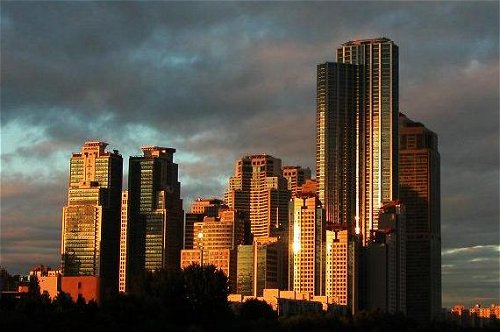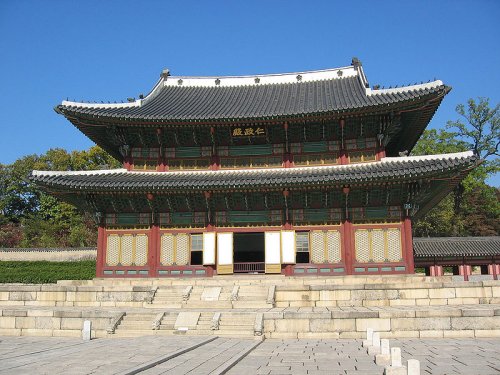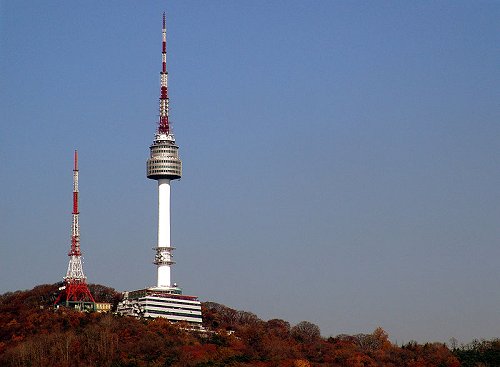 Seoul, South Korea
Seoul, South KoreaSource: https://commons.wikimedia.org/wiki/File:Near_by_han_river.jpg
Author: Patriotmissile

Seoul 서울 is the capital and largest city in South Korea. It is a city of over 10 million people. The metropolitan area of Seoul, called the Seoul National Capital Area, includes the city of Incheon, itself the third largest city in South Korea, as well as much of Gyeonggi Province, together holding a population of about 25 million people - almost half of the total population of South Korea. It is the second largest metropolitan area in the world behind Tokyo and in front of Mexico City.
Seoul is located on the banks of the Han River. The area has been settled as early as 18 BC, when the Kingdom of Baekje - one of thge Three Kingdoms of Korea - established its capital to the southeast of present-day Seoul.
Seould was the capital of Korea during the Joseon Dynasty (1392-1897) as well as the Korean Empire (1897-1910). As such it is home to many royal palaces that are today national monuments.
Seoul was known as Hanyang and then Hanseong throughout the Joseon Dynasty. The medieval city was enclosed by high walls punctuated by nine gates, of which five are still standing, and two of the biggest are Namdaemun and Dongdaemun.
When Japan invaded Korea in 1910, Seoul was made the colonial capital until the defeat of Japan in World War II. During the Korean War in 1950, there was a tussle for control over Seoul between the China-backed North Korean forces and the UN-back South Korean forces. When the Soviet Union and China came forward to assist North Korea, there was heightened threat of a world wide nuclear war, averted by the signing of an armistice on 27 July 1953. (North Korea unilaterally withdrew from the armistice on 27 May, 2009, in principle going back to a state of war).
 Skyscrapers of Tower Palace, Seoul
Skyscrapers of Tower Palace, SeoulSource: https://commons.wikimedia.org/wiki/File:Towel_Palace.jpg
Author: Patriotmissile

 Injeongjeon, the main hall of Changdeokgung Palace, Seoul
Injeongjeon, the main hall of Changdeokgung Palace, SeoulSource: https://en.wikipedia.org/wiki/Changdeokgung
Author: eimoberg

The effect of the Korean War was utter devastation for Seoul, which also had to live with a flood of North Korean refugees, swelling its population of 2.5 million people. The South Korean government swiftly embarked on a reconstruction and modernization program. Standard of living started to rise through the 1960's and 70's. The city experience a construction boom of infrastructure and housing in the 1980's, entirely transforming the cityscape, but at the same time making traffic jams common place.
Seoul is today a densely populated metropolis, and one of the most expensive cities in the world. To relieve the pressure of congestion, the South Korean Government has since late 2004 begun relocating many of its government bodies to the city of Gongju, 120 kilometers south of Seoul, and at a more comfortable distance from the border with North Korea. Seoul remains a capital by name - it is not constitutional to move it without a national referendum or revision of the constitution.
 Seoul Tower
Seoul TowerSource: https://commons.wikimedia.org/wiki/File:Seoul_Tower_2.jpg
Author: Danleo

Going to Seoul
The Incheon International Airport (ICN) is the main gateway to Seoul and to South Korea. It is located on an island in neighboring Incheon.Leaving the airport by bus
The most practical was to leave Incheon Airport is to take an airport limousine bus. The fare to downtown Seoul is ₩14,000, stopping at major hotels in Seoul. If you are transferring to Gimpo Airport for a domestic flight, the fare is ₩6,500.
A more economical option is to take the public bus. It goes from Incheon Airport to the bus hub in downtown Seoul, and costs around ₩8,000 to ₩9,000. If you are in doubt which bus to take, ask one of the ticket sellers.
Leaving the airport by train
The Korea Airport Railroad Express, AREX is an express train out of Incheon Airport. Unfortunately at the moment it runs all the way till Gimpo Airport only, so if you take it, you still have the transfer to a subway, taking Line 5 or Line 9 to reach downtown Seoul. The AREX is presently being extended to Seoul, but the phase is not completed yet. If you are lugging a lot of baggage, then I would suggest you take the limousine bus.
Travel within Seoul
Seoul has an extensive subway network covering most of the places within the city. There are presently 9 Metropolitan Subway Lines, excluding the Bundang Line and the Incheon Line. They are all color coordinated to help you differentiate one from the other. All signages include English. For the latest subway map, visit the Seoul Metropolitan Rapid Transit website.The Seoul subway fare is charged according to distance traveled. It starts at ₩1000. Tickets are sold by vending machines, all of which accept coins and a few banknotes too. However, the machines will not take a note of high denomination, say ₩10,000. Nonetheless there is usually a bill exchanger nearby.
If you plan to use the subway often, you should get the stored value T-Money smart card. The card itself costs ₩2,500, but you save ₩100 each time you make a transfer. The T-Money card can also be used to pay taxi fares, bus fares and other conveniences.
Sights in downtown Seoul
- Seoul Tower 240-meter tower standing on 274-meter Namsan Mountain.
- Korea House One of the best Korean restaurants in Seoul, on the slopes of Namsan.
- Namsangol Hanok Village Living museum showcasing the traditional life in Korea.
- Namdaemun (Great South Gate) Medieval gate of the walled city of Seoul.
- Dongdaemun (Great East Gate) Another medieval gate of the old walled city.
- City Hall Plaza City square with City Hall to the north, considered the very heart of Seoul.
- Gwanghwamun (Gate of Transformation by Light) Reconstructed medieval gate in front of Gyeongbok Palace
- Gwanghwamun Intersection Major traffic intersection with the statue of 16th century hero Yi Sun-sin.
- Boskingak Bell tower at Jongno intersection.
- Gyeongbokgung Palace (Palace of the Heavenly Blessings) The largest of the Five Grand Palaces of the Joseon Dynasty
- National Folk Museum of Korea Museum located within the grounds of the Gyeongbokgung Palace.
- Gyeonghoeru Pavilion State banquet hall built in 1412, with the grounds of the Gyeongbokgung Palace.
- Hyangwonjeong Pavilion Two storey hexagonal pavilion within the grounds of Gyeongbokgung Palace.
- National Museum of Korea The main museum of Korean history and art, in Yongsan Family Park.
- Myeongdong One of the main shopping districts of Seoul, 10 minutes from City Hall Plaza
- Myeongdong Cathedral Oldest Catholic cathedral in Korea.
- Deoksugung Palace (Palace of Virtuous Longevity) Residence of Korean royalty 1919.
- Royal Museum Museum within the grounds of the Deoksugung Palace displaying items once used by the royal court.
- Changdeokgung Palace (Palace of Illustrious Virtue) Another palace from the Joseon Dynasty, also called East Palace.
- Biwon Former private park of the royal family.
- Changgyeonggung Palace Summer Palace of the Goryeo Emperor, within the largest public park in Seoul.
- Jongmyo Royal Ancestral Shrine, across from Changgyeonggung Palace.
- Sungkyunkwan University National institute with history going back to the Joseon Dynasty.
- Munmyo Shrine Shrine honoring Confucius within grounds of Sungkyunkwan University.
- Jogyesa Temple Headquarters of the official sect of Buddhism in Korea.
- Namdaemun Sijang (Great South Gate Market) A major Seoul market.
- Dongdaemun Sijang (Great East Gate Market) An even bigger market, three times Namdaemun Sijang.
- Insadong Locality in Seoul with lots of antique shops.
- Tapgol Park Park with a Joseon Dynasty pagoda in its center.
Sights around Seoul
- Hwanghakdong Flea Market A big market place for second-hand goods.
- Gyeongdong Oriental Medicine Market A place to browse at ginseng and all the roots and herbs.
- Janghanpyeong Antique Market A cluster of shops and mall specializing in antiques.
- Daeheungno Nightlife precinct favored by students from neighboring universities.
- Wedding Street Street with shops specializing in wedding downs.
- Itaewon A locality on the southern flank of Namsan, famous for shopping and nightclubs.
- War Memorial Memorial with museum of Korea's military history.
- Yongsan Electronics Market Shopping precinct specializing in electronic goods, to the southwest of the War Memorial.
- Hangang Citizen's Park Public recreational area in Seoul.
- Seoul World Cup Stadium Stadium built for the 2002 World Cup.
- Hyperion Tower Tallest building in Seoul, and second tallest in South Korea.
- 63 Building Second tallest building in Seoul, and third tallest in South Korea.
- Noryangjin Fish Market A good place to gawk at all the fish and marine life destined for Korean tables.
- Apgujeong An upscale neighborhood with high-class branded stores and boutiques.
- Seoul Nori Madang Outdoor amphitheater for Korean folk performances.
- Amsadong Prehistoric Settlement Site Largest archaeological site for Neolithic remains in South Korea.
- Korea World Trade Center A major center of business in Seoul.
- Korea Exhibition Center (KOEX) Exhibition center for auto shows, travel fairs and the like, located next to the Korea World Trade Center.
- Bongeunsa One of the oldest temples in Seoul, on hill behind KOEX.
- Seoul Arts Center Modern theater complex on the south side of the Han River.
- National Center for Korean Traditional Performing Arts Center for viewing traditional Korean court music and dance.
 Latest updates on Penang Travel Tips
Latest updates on Penang Travel Tips
 Discover with Timothy YouTube Channel
Discover with Timothy YouTube Channel
 PG Food Channel
PG Food Channel
 Learn Penang Hokkien YouTube Channel
Learn Penang Hokkien YouTube Channel
 SojiMart Videos
SojiMart Videos
 Share your travels and/or ask a travel-related question
Share your travels and/or ask a travel-related question
Join the Penang Travel Tips Facebook Group to share photos, tips and anything related to your travels, or ask travel-related questions.
 Map of Roads in Penang
Map of Roads in Penang
Looking for information on Penang? Use this Map of Roads in Penang to zoom in on information about Penang, brought to you road by road. Discover with Timothy
Discover with Timothy
Let me take you to explore and discover Penang through my series of walking tours on YouTube. You may use these videos as your virtual tour guide. At the beginning of each video, I provide the starting point coordinates which you may key into your GPS, Google Maps or Waze, to be navigated to where I start the walk, and use the video as your virtual tour guide.Disclaimer
Please use the information on this page as guidance only. The author endeavours to update the information on this page from time to time, but regrets any inaccuracies if there be any.Latest from Discover with Timothy: Gurney Bay - what to see and do there
About this website

Hello and thanks for reading this page. My name is Timothy and my hobby is in describing places so that I can share the information with the general public. My website has become the go to site for a lot of people including students, teachers, journalists, etc. whenever they seek information on places, particularly those in Malaysia and Singapore. I have been doing this since 5 January 2003, for over twenty years already. You can read about me at Discover Timothy. By now I have compiled information on thousands of places, mostly in Peninsular Malaysia and Singapore, and I continue to add more almost every day. My goal is to describe every street in every town in Malaysia and Singapore.
Robbie's Roadmap
- Episode 1: Robbie's Journey to Financial Freedom
- Episode 2: Lost in America
- Episode 3: The Value of Money
- Episode 4: The Mentor
- Episode 5: The Thing that Makes Money
- Episode 6: The walk with a Billionaire
- Episode 7: The Financial Freedom Awakening
- Episode 8: Meet Mr Washington
- Episode 9: The Pizzeria Incident
Copyright © 2003-2024 Timothy Tye. All Rights Reserved.


 Go Back
Go Back